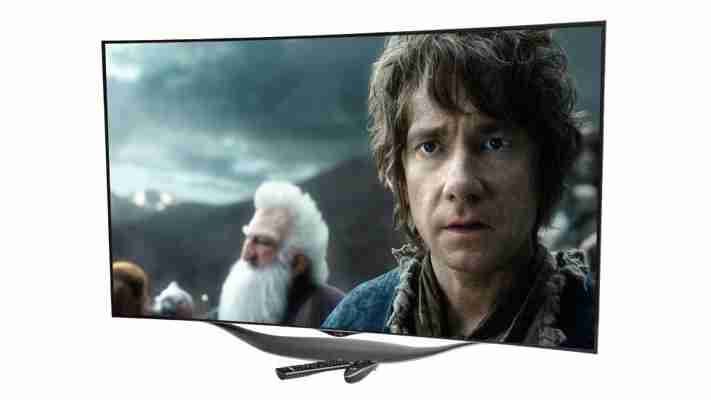LG 55EC930V OLED review
It’s been a long time coming, but OLED TVs are finally making their way to UK shops, and LG’s curved 55EC930V is easily the best looking set we’ve seen. Only available in a 55in model, the 55EC930V is an astonishing 6mm at its thinnest point, making it slimmer than most smartphones. This is rather negated by the TV’s subtle curve, as the set expands to a more sizeable 80mm without the stand if you want to wall-mount it or 204mm with the stand, but it’s still one of the most stylish TVs around.
OLED has long been heralded as the future of TV and its main advantage over LCD, and indeed the now-defunct plasma technology, is that it produces much deeper blacks, making those letterbox bars truly pitch black when watching films. This is because each individual pixel generates its own light rather than being illuminated by LEDs, so pixels are simply switched off when they need to display absolute black. This in turn also generates much higher contrast levels than rival panels, allowing you to see more detail and a wider variety of light and shade.
IMAGE QUALITY
The 55EC930V performed admirably on this front in our technical tests, producing perfect 0.00cd/m2 black levels and a contrast ratio reading so high that our colour calibrator couldn’t even give us a score. Unsurprisingly, this gave a real boost to our Star Trek Blu-ray, as the depths of space were truly black and tiny distant stars were pin-sharp, showing no signs of the hazy halo effect we sometimes see on locally-backlit LCD sets. Night scenes were also bursting with detail, as we could see every last shred of shadow gradient even with the lights turned on in our test room.
It certainly makes for a stunning-looking picture, but the 55EC930V’s colour accuracy isn’t quite so impressive. Smartphone OLED screens we’ve tested have nearly always produced perfect sRGB colour gamut scores, but straight out of the box on the Standard picture mode, we measured an sRGB gamut coverage of 96.4 per cent. This is still very respectable, as most LCD sets we've tested only manage around 90 per cent, but our measurements showed the 55EC930V's blue coverage was much stronger than anything else, resulting in shorter greens, yellows and reds and a cooler image overall.
In fact, all four of the 55EC930V’s colour temperatures were heavily skewed toward the blue end of the spectrum, but Warm 2 was by far the most balanced, so we stuck with this one for the rest of our testing. We also switched to Cinema mode when calibrating the TV, as we noticed a distracting, blocky flicker effect when some faces were in close-up on Standard mode, as if the pixels couldn’t decide which colour they wanted to show. This isn’t something we’d expect to see on such a high-end TV, but fortunately this disappeared in Cinema mode. The rest of the 55EC930V's picture modes were also far too sharp, harsh and garish for our liking, so we'd recommend using either Cinema or the two ISF Expert modes for watching films and TV.
Using our colour calibrator, we calibrated the TV using the 2-point white balance options in the Expert Control menu, adjusting Red to +10, Green to -4 and Blue to -10. With these settings, colours looked much warmer and more natural, even if it did result in a slightly lower gamut score of 95.9 per cent. However, reds and greens were much better represented on the sRGB colour gamut and blues were much closer to the sRGB colour boundary, resulting in a more pleasing picture to the eye.
The rest of the picture options give you plenty to adjust, including basic contrast, brightness, sharpness, colour and tint controls, and as well as gamma, dynamic contrast and super resolution options in the Expert Control menu. The latter helps sharpen blurry or lower resolution content for a clearer picture. There’s also a full colour management system, which lets you alter the saturation, tint and luminance of the six main primary colours just in case the white balance options aren’t enough for you.
The 55EC930V’s noise reduction settings are quite strong, but they really help eliminate unwanted artefacts and jagged edges on standard definition TV. This had the downside of smoothing over any kind of detail, but this is to be expected. Noise reduction wasn't so necessary on HD TV channels, as there was a lot more detail on show, so we left them turned off here.
The 55EC930V also has LG’s TruMotion engine, which inserts extra frames into your films to make them appear smoother. This can help to even out jerky camera pans or rapid action sequences, but we found that the Smooth option was far too strong, creating a very slight amount of screen tear as the frames struggled to keep up with the action onscreen. Clear looked much more natural, but we found the User mode provided the best balance, as you can adjust the amount of de-juddering and de-blurring yourself.
AUDIO
Home cinema enthusiasts will no doubt want to connect a separate sound system for the full cinematic experience, but we were still impressed by the 55EC930V’s 40W speakers. There are six sound profiles to choose from, but all of them produced clear dialogue in both films and TV shows. LG’s Smart Sound mode also did an admirable job of widening the soundstage to make background music and surrounding voices more prominent, but it also had a tendency to drown out the main dialogue, so we kept it turned off.

Your comment